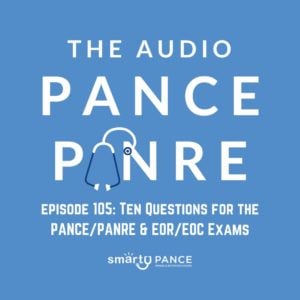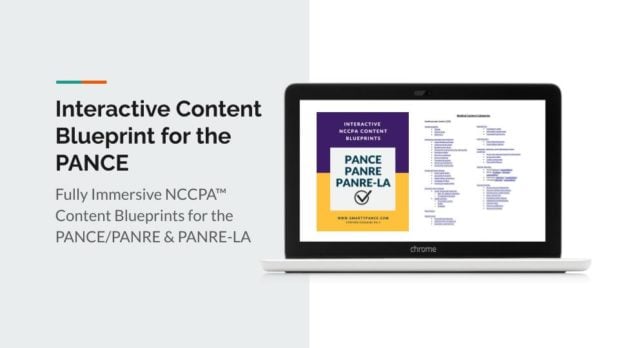Podcast: Play in new window | Download
Subscribe: Apple Podcasts | RSS
Listen to Podcast Episode 105: Ten PANCE, PANRE, and Rotation Review Questions
If you can’t see the audio player, click here to listen to the full episode.
 Welcome to episode 105 of the Audio PANCE and PANRE Physician Assistant/Associate Board Review Podcast.
Welcome to episode 105 of the Audio PANCE and PANRE Physician Assistant/Associate Board Review Podcast.
Join me today as we cover ten board review questions for your PANCE, PANRE, EOR, and EOC exams.
Links from today’s episode:
- Sign up for the Entire Blueprint Email Series
- Follow Smarty PANCE and The Daily PANCE Blueprint on Instagram
- Follow Smarty PANCE and The Daily PANCE Blueprint on Facebook
- Review systemic lupus erythematosus (SLE)
- Review the diabetes diagnostic guidelines
- Review gestational diabetes screening guidelines
- Review basal cell carcinoma and our comparison tables of the Blueprint dermatologic neoplasms
- Join the Smarty PANCE Member’s Community, then sign up for a study group to get updates about upcoming webinars.
I hope you enjoy this free audio component of the examination portion of this site. Smarty PANCE includes over 2,000 interactive board review questions, along with flashcards, ReelDx cases, integrated Picmonics, and lessons covering every blueprint topic available to all Smarty PANCE members.
- You can download and listen to past FREE episodes here, on iTunes, Spotify, Google Podcasts, Stitcher, Amazon Music, and all podcasting apps
- You can listen to all the latest episodes, take interactive quizzes, and download more resources on each episode page.
Interactive exam to complement today’s podcast
1. A 68-year-old male farmer presents with a flesh-colored papule with a rolled border located on the right side of his forehead. As you examine the lesion closely, you notice something else about the lesion. Which of the following physical exam findings would make you more suspicious of malignancy?
A. Telangiectasia
B. Nikolsky sign
C. Hypopigmentation
D. Tenderness to palpation
E. Central umbilication
Smarty PANCE Content Blueprint Review:
Covered under ⇒ PANCE Blueprint Dermatology ⇒ Dermatologic Neoplasms ⇒ Basal cell carcinoma
Also covered as part of the General Surgery EOR and Family Medicine EOR topic list
2. Which of the following is the most common type of elder abuse?
A. Neglect
B. Emotional abuse
C. Physical abuse
D. Sexual abuse
E. Financial exploitation
Smarty PANCE Content Blueprint Review:
Covered under ⇒ PANCE Blueprint Psychiatry ⇒ Abuse and Neglect ⇒ Child/elder abuse
3. Which of the following is the most common bacterial cause of a hordeolum?
A. Streptococcus pyogenes
B. Staphylococcus aureus
C. Clostridium perfringens
D. Propionibacterium species
E. Enterobacter aerogenes
Smarty PANCE Content Blueprint Review:
Covered under ⇒ PANCE Blueprint EENT ⇒ Disorders of the Eye ⇒ Lid disorders ⇒ Hordeolum
Also covered as part of the Family Medicine EOR topic list
4. A 19-year-old female presents to the clinic with fatigue, weight loss, arthralgia, and an erythematous rash in a malar distribution over the cheeks and nose (that spares the nasolabial folds). Which of the following is the most common cardiac manifestation of the patient’s likely diagnosis?
A. Third-degree AV block
B. Mitral regurgitation
C. Myocarditis
D. Pericarditis
E. Bradydysrhythmias
Smarty PANCE Content Blueprint Review:
Covered under ⇒ PANCE Blueprint Musculoskeletal ⇒ Rheumatologic Disorders ⇒ Systemic lupus erythematosus
Also covered as part of the Internal Medicine EOR and Family Medicine EOR topic list
5. Which of the following is the most common and important risk factor for aortic dissection?
A. Bicuspid aortic valve
B. Connective tissue disorder
C. Turner’s syndrome
D. Systemic hypertension
E. Aortic surgery
Smarty PANCE Content Blueprint Review:
Covered under ⇒ PANCE Blueprint Cardiology ⇒ Vascular Disease ⇒ Aortic aneurysm/dissection
6. Which of the following is characterized by a rash that has a “slapped cheek” appearance at first and then progresses into a maculopapular rash on the arms and trunk in a reticular pattern?
A. Roseola infantum
B. Rubella
C. Measles
D. Erythema infectiosum
E. Kawasaki disease
Smarty PANCE Content Blueprint Review:
Covered under ⇒ PANCE Blueprint Infectious Disease ⇒ Viral Infectious Disease ⇒ Erythema infectiosum
Also covered as part of the Pediatric Rotation EOR topic list
7. Which of the following is the most common cause of generalized musculoskeletal pain in young adult females?
A. Multiple sclerosis
B. Rheumatoid arthritis
C. Polymyalgia rheumatica
D. Menstruation
E. Fibromyalgia
Smarty PANCE Content Blueprint Review:
Covered under ⇒ PANCE Blueprint Musculoskeletal ⇒ Rheumatologic Disorders ⇒ Fibromyalgia
Also covered as part of the Internal Medicine EOR and Family Medicine EOR topic list
8. Which of the following is the best first-line treatment for a post-menopausal woman with osteoporosis and no pathological fractures?
A. Bisphosphonates
B. Parathyroid hormone analogs
C. RANKL inhibitors
D. Selective estrogen receptor modulators
E.Calcitonin
Smarty PANCE Content Blueprint Review:
Covered under ⇒ PANCE Blueprint Musculoskeletal ⇒ Rheumatologic Disorders ⇒ Osteoporosis
Also covered as part of the Family Medicine EOR topic list
9. A 72-year-old female with sick sinus syndrome (s/p pacemaker) presents to your clinic with fever and chills. On a physical exam, you appreciate a new murmur located at the left 5th intercostal space at the midclavicular line. You also notice petechiae on the patient’s conjunctivae. Which of the following is the most likely diagnosis?
A. Bacterial pneumonia
B. Pericarditis
C. Rheumatic fever
D. Infective endocarditis
E. Pleural effusion
Smarty PANCE Content Blueprint Review:
Covered under ⇒ PANCE Blueprint Cardiology ⇒ Traumatic, infectious, and inflammatory heart conditions ⇒ Acute and subacute bacterial endocarditis
Also covered as part of the Emergency Medicine EOR, Internal Medicine EOR, and Family Medicine EOR topic list
10. Which of the following is not considered diagnostic for diabetes mellitus?
A. Random plasma glucose > 200 mg/dL with symptoms of hyperglycemia
B. A1c > 6.5
C. Fasting plasma glucose > 126 mg/dL on at least two separate occasions
D. Plasma glucose > 200 mg/dL measured after a glucose tolerance test
E. All of the above are diagnostic
Smarty PANCE Content Blueprint Review:
Covered under ⇒ PANCE Blueprint Endocrinology ⇒ Diabetes Mellitus ⇒ Diabetes Mellitus Type 2
Also covered as part of the Family Medicine EOR and Emergency Medicine EOR topic list
This podcast is available on every device!
You can download and listen to past FREE episodes here, on iTunes, Spotify, Google Podcasts, Stitcher, Amazon Music, and all podcasting apps.
Download Interactive Content Blueprint Checklists for the PANCE, PANRE, EOR, and PANRE-LA
Follow this link to download your FREE copy of the PANCE/PANRE/EOR Content Blueprint Checklists.
Print it up and start crossing out the topics you understand, marking the ones you don’t, and making notes of key terms you should remember. The PDF version is interactive and linked directly to the individual lessons on Smarty PANCE.
Smarty PANCE is not sponsored or endorsed by, or affiliated with, the National Commission on Certification of Physician Assistants.

